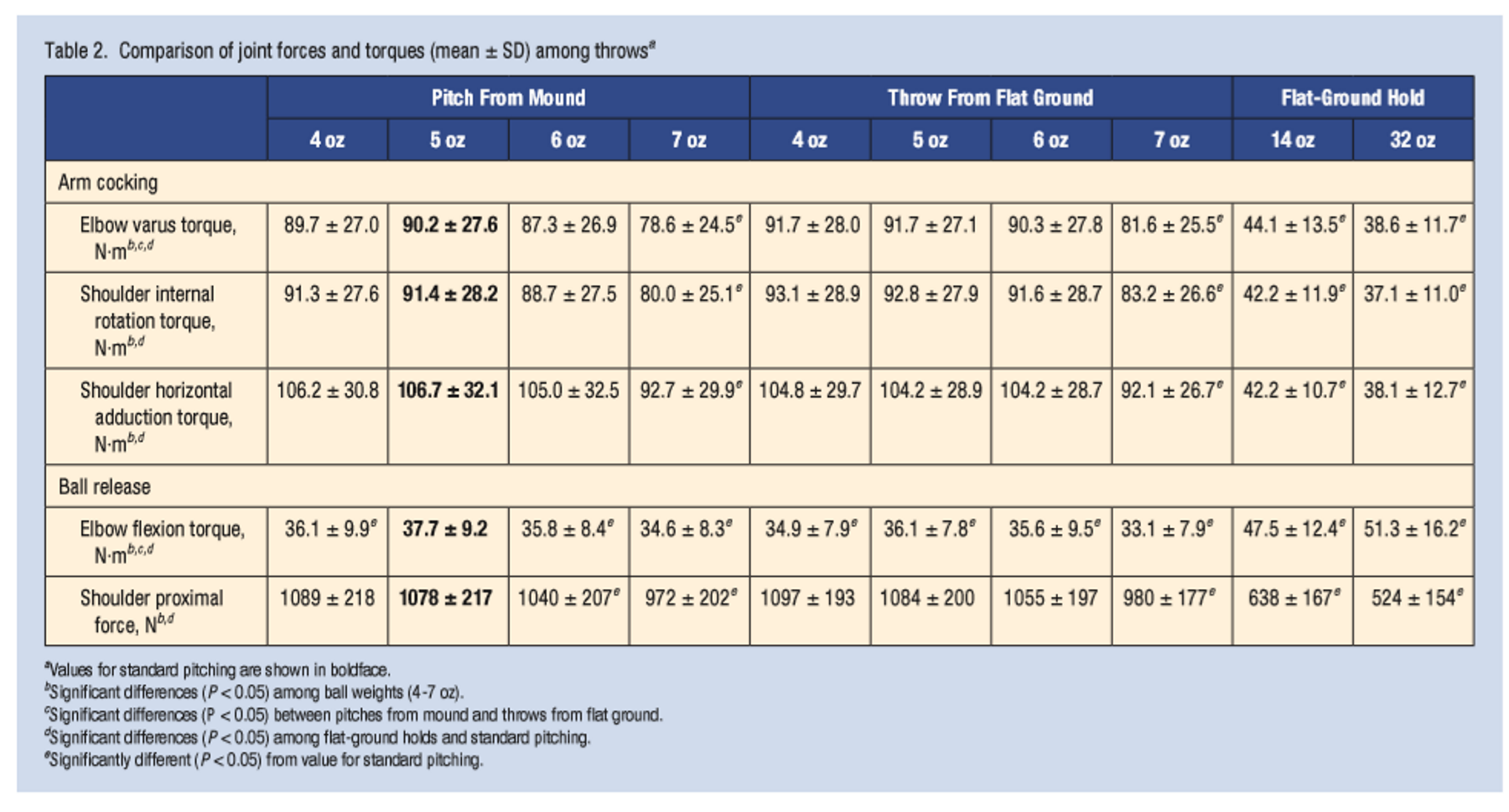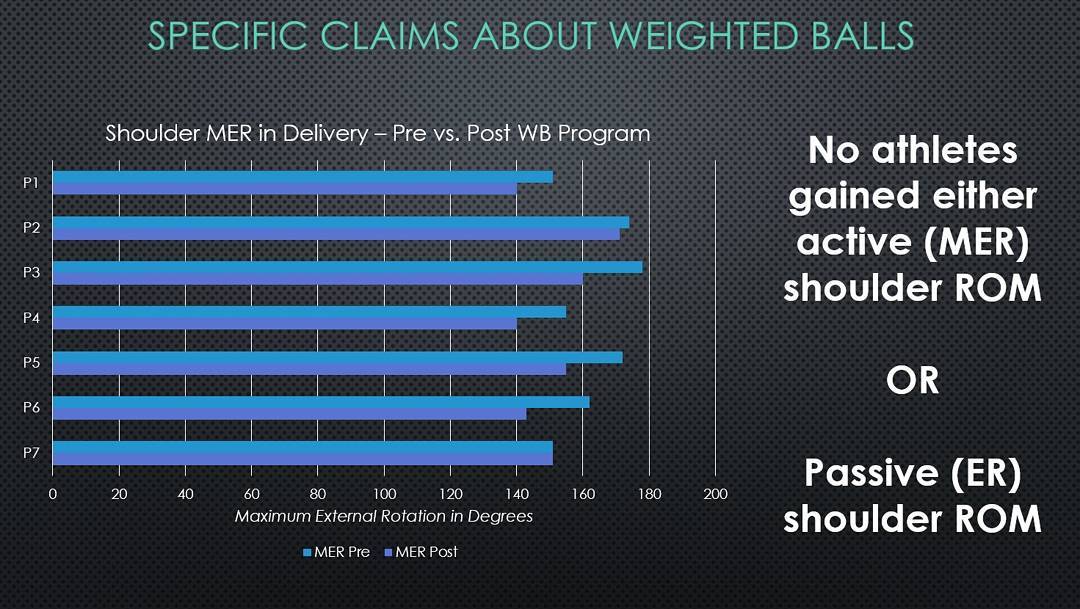Comparing Overload vs. Underload Weighted Ball Stress on the Arm

Weighted baseball training has become ever more popular at both the amateur and professional level. Several MLB teams consult with Driveline Baseball to provide products and services to their athletes and coaches, and college players around the country are using forms of overload and underload training to improve velocity, performance, command, and arm health. This blog article will provide an analytical look at overload vs. underload weighted ball throwing from a velocity and torque/stress point of view to answer a question: Are weighted baseballs inherently more dangerous to throw than regular baseballs?
Our starting hypothesis was that lighter/underload baseballs were more stressful to the elbow and heavier/overload baseballs were less stressful to the elbow, despite some research showing no statistical difference. Let’s get into it!
(This article was written by Kyle Boddy, Director of Research and Development at Driveline Baseball. Data was collected by the R&D team.)
A Quick Review of the Research
In ASMI’s breakthrough paper, Biomechanical Analysis of Weighted-Ball Exercises for Baseball Players, Dr. Fleisig et al. published a huge trove of data on “flat ground” (high effort crow hop) throws using weighted baseballs to examine the kinematic and kinetic differences on the arm. The data chart below shows that data, which first appeared in our blog post: Weighted Baseball Research and the Data Supporting Their Use:
The results from the study showed:
In general as ball mass increased, elbow and shoulder joint torques and forces decreased for both mound and crow hop throws.
As ball mass increased angular velocities of pelvis, upper trunk, shoulder and elbow decreased for both mound and crow hop throws. The exception was the 4 oz ball, which was not significantly different than a 5 oz ball.
We have since investigated the stress differences between pulldowns and pitching and found similar results to the ASMI study.
The kinetic data from Dr. Fleisig’s paper is shown below (click for larger size):
The only statistically significant kinetic difference at the elbow for weighted ball throwing from a crow hop was that the overload 7 oz. ball was less stressful than a regulation baseball.
Nevertheless, I decided to poll my Twitter followers (651 votes) to see what their guess would be on what max effort throw would be the most stressful, and the 3 oz. underload ball won in a landslide, with 71% of the voters choosing either underload implement as the most stressful over the regulation and overload implement:
Issues with Existing Research
While ASMI’s paper on weighted baseballs is both rigorous and important, the subject pool did not display elite velocities when throwing weighted baseballs from a crow hop. The average velocity of a standard baseball crow hop throw in the paper was only ~84 MPH (37.7 m/s), which is well below what an average professional pitcher or position player would throw a baseball.
This is a problem with most research studies – the subject pool is not close to elite performers, since elite athletes don’t readily subject themselves to invasive or potentially dangerous testing, and throwing weighted baseballs is a “risky” endeavor in many peoples’ minds. Fortunately, at Driveline Baseball, we train hundreds of hard-throwing elite athletes.
Furthermore, the ASMI paper had subjects who most likely had little to no experience throwing weighted baseballs, which does lead to anomalies due to unfamiliarity. This can (but does not always) manifest itself as counter-intuitive results when the weight of an implement deviates too far from the regular object.
Study Design and Results
We took twenty-seven (n=27) athletes from our database who threw max effort crow hop throws with a 3, 4, 5, 6, and 7 oz ball where we had both velocity data AND MotusBASEBALL markers on each throw.
The MotusBASEBALL wearable device measures:
- Elbow Stress (Newton-meters)
- Shoulder Rotation (degrees)
- Arm Speed (proprietary number)
- Arm Slot (degrees)
We’ll be tracking both the Elbow Stress and Shoulder Rotation in this particular study. The MotusBASEBALL device was partially validated against motion capture technology as per this case study (PDF) released by Motus Global.
I took the peak velocity per athlete per ball for this study. This means if I threw a 5 oz. baseball 87, 84, and 83 MPH, I used the associated data from the 87 MPH throw from the MotusBASEBALL device and threw out the rest, then repeated that calculation per ball weight.
With n=27, this was the approximate breakdown when those numbers were averaged:
Our subject pool averaged 93.4 +/- 5.5 MPH with a standard baseball, which is 9 MPH faster than ASMI’s research and much closer to a representation of an elite college or professional athlete. The “delta from 5 oz” shows the difference between each ball and a regulation baseball.
The following chart details the mean and standard deviation of the population of both Elbow Stress and Shoulder Rotation, two markers hypothesized to be linked to arm injuries:
RESULTS: None of the differences in that chart are statistically significant. (The full dataset can be downloaded here for replication and further analysis purposes.)
[clickToTweet tweet=”There is no difference in elbow stress or shoulder rotation between 3-7 oz weighted baseballs.” quote=”There is no difference in elbow stress or shoulder rotation between 3-7 oz weighted baseballs.”]
If anything, the regulation baseball is the most stressful on the elbow!
Some experts in various fields have hypothesized that heavier implements (6 and 7 oz balls in this study) lead to greater range of motion in shoulder rotation, leading to a pathway to injury through increased external rotation laxity, but the data from this study does not support such a hypothesis. Furthermore, data from a previous n=7 study done with professional athletes who went through an intensive five-week weighted ball training program showed no gain of either acute (static) or dynamic (MER during delivery) range of motion in the shoulder (click for full size):
Conclusion: No Statistical Difference in Stress
There is no evidence in this 27-person study to show that either elbow stress or shoulder rotation ROM changes depending on the weight of the implement used. It is possible with a full marker-based solution that results would be different instead of relying on the Motus MotusBASEBALL sleeve, or with a different population or weighted ball velocity spread the results would change. However, there exists insufficient evidence in this study (and other studies) to suggest that either underload implements or overload implements are more stressful on the arm compared to a baseball when thrown at max effort.
We looked into the stress of Plyo Ball ®® velocities, hybrid B days, and how they compare to pitching stress here.
Supplementary Chart: High-Performance vs. Average
This section was added March 5th, 2017 by Kyle Boddy.
Since our initial hypothesis seemed to be proven incorrect, I took a deeper look at the data and separated out everyone who could throw a 3 oz. underload baseball 100+ MPH and labeled them the “high-performance group.” This gave us a subject pool of ten (n=10) and I ran the same analysis I did above to this group. My hypothesis was that since velocity was statistically significantly higher than the average group, elbow stress would likely be statistically higher as well.
Surprisingly, this was not the case. The high-performance group had statistically insignificant changes in elbow stress across the board despite much higher velocities.
The last thing to do, then, is to remove the high-performance athletes from the average and split off the remainder (“low-performance,” though obviously these people throw very hard still for a research group) to see if there were statistically significant differences in stress between the groups.
Not surprisingly, the differences in velocity between the groups are statistically significant below even p < 0.01, but none of the stress markers come close to being statistically significant at p < 0.05. Despite having superior velocity by a long shot, the stress changes between the groups are negligible – confirming what we already know, that mechanics, levers, and other factors play a role in generating stress, not just velocity.
(For a deeper look in general at weighted baseball training, check out our exhaustive blog article on the topic here.)
Comment section
Add a Comment
You must be logged in to post a comment.



Adam -
Any thoughts on why the 5 oz baseball is the most stressful?
Kyle Boddy -
The differences are not statistically significant, but if they had been, I would guess that it would be because pitchers have the most experience throwing a 5 oz ball and impart the most force in doing so.
Pulldowns: The What, Why, and When - Driveline Baseball -
[…] by looking at 5-oz throws with the Motus sleeve and found similar results. We also looked at the stress of throwing 3-7 oz balls during pulldowns and found little no statistical difference between the […]